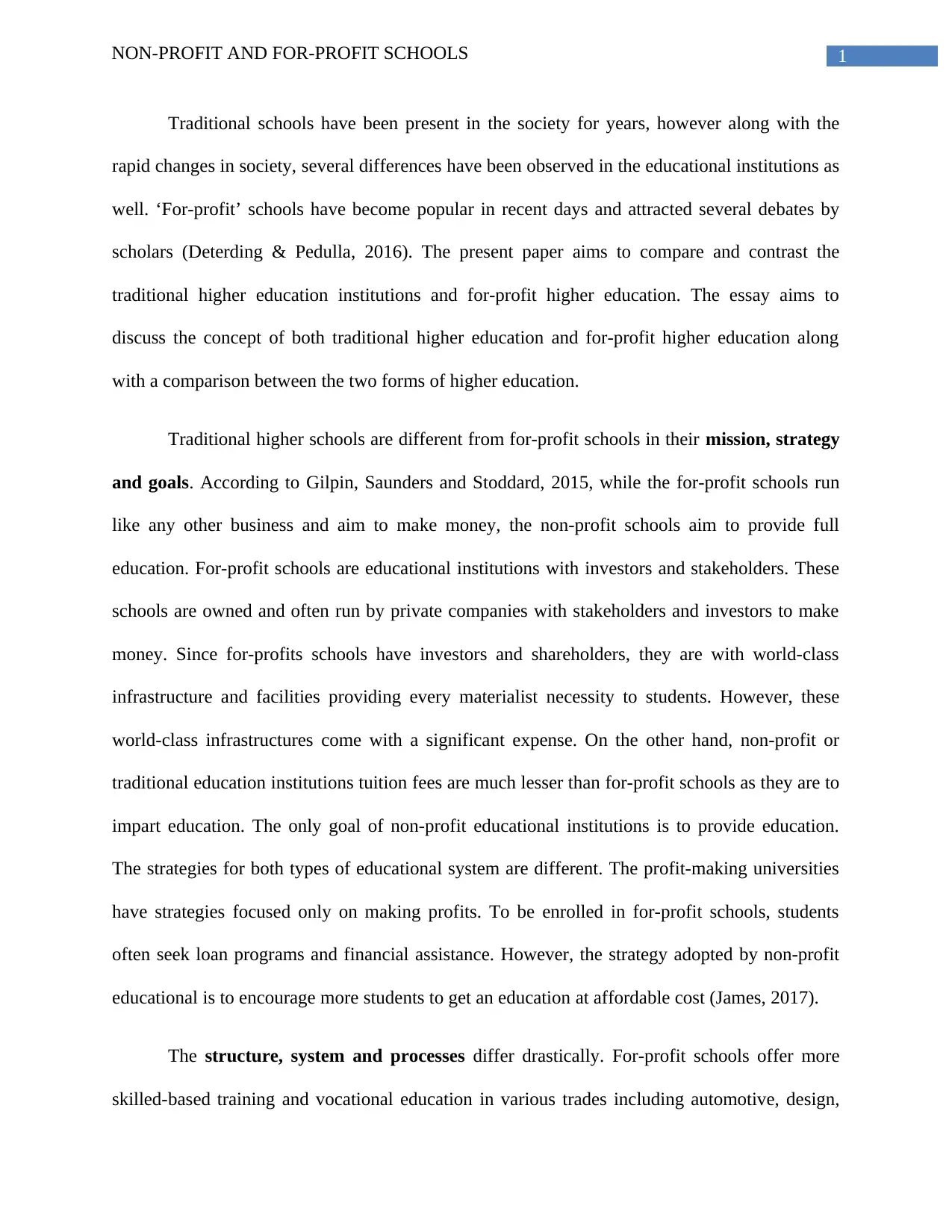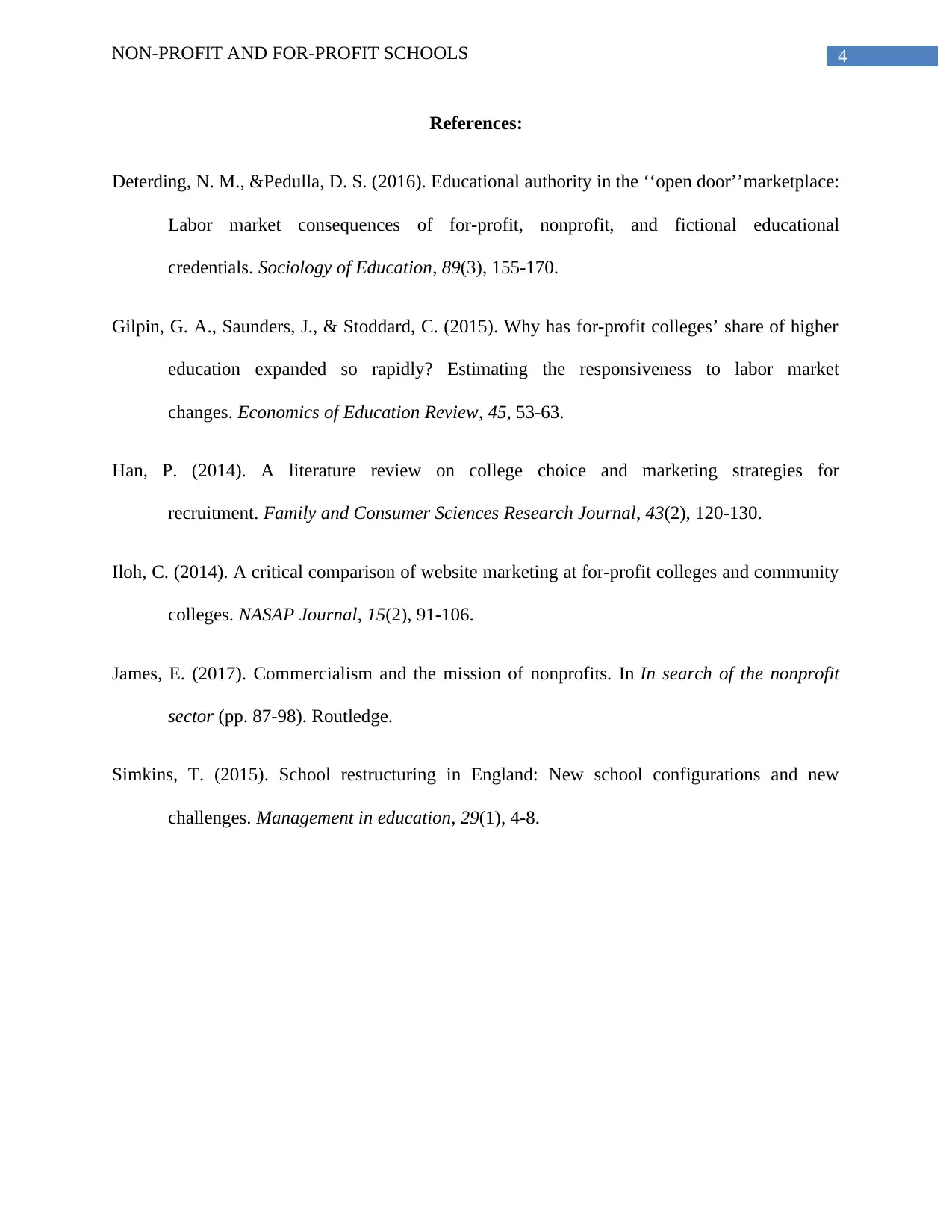Non-Profit and For-Profit Schools: A Detailed Comparison of Systems
VerifiedAdded on 2023/04/20
|5
|1142
|68
Essay
AI Summary
This essay provides a comprehensive comparison between traditional non-profit higher education institutions and for-profit higher education models. It highlights the fundamental differences in their missions, strategies, and goals, noting that while non-profit schools focus on providing education, for-profit schools operate with a business-oriented approach aimed at generating revenue for investors and stakeholders. The essay discusses variations in funding sources, infrastructure, tuition fees, and the types of programs offered, with for-profit schools often emphasizing skilled-based training and vocational education. It also addresses the marketing and recruiting processes, student support, and the perceived value of degrees from each type of institution, ultimately recommending that for-profit schools amend their policies to improve the future of higher education and career prospects for their students. The essay concludes that while both types of institutions have advantages and disadvantages, understanding these differences is crucial for students when choosing a program.

Running head: NON-PROFIT AND FOR-PROFIT SCHOOLS
NON-PROFIT AND FOR-PROFIT SCHOOLS
Name of the school:
Name of the university:
Author note:
NON-PROFIT AND FOR-PROFIT SCHOOLS
Name of the school:
Name of the university:
Author note:
Paraphrase This Document
Need a fresh take? Get an instant paraphrase of this document with our AI Paraphraser

1NON-PROFIT AND FOR-PROFIT SCHOOLS
Traditional schools have been present in the society for years, however along with the
rapid changes in society, several differences have been observed in the educational institutions as
well. ‘For-profit’ schools have become popular in recent days and attracted several debates by
scholars (Deterding & Pedulla, 2016). The present paper aims to compare and contrast the
traditional higher education institutions and for-profit higher education. The essay aims to
discuss the concept of both traditional higher education and for-profit higher education along
with a comparison between the two forms of higher education.
Traditional higher schools are different from for-profit schools in their mission, strategy
and goals. According to Gilpin, Saunders and Stoddard, 2015, while the for-profit schools run
like any other business and aim to make money, the non-profit schools aim to provide full
education. For-profit schools are educational institutions with investors and stakeholders. These
schools are owned and often run by private companies with stakeholders and investors to make
money. Since for-profits schools have investors and shareholders, they are with world-class
infrastructure and facilities providing every materialist necessity to students. However, these
world-class infrastructures come with a significant expense. On the other hand, non-profit or
traditional education institutions tuition fees are much lesser than for-profit schools as they are to
impart education. The only goal of non-profit educational institutions is to provide education.
The strategies for both types of educational system are different. The profit-making universities
have strategies focused only on making profits. To be enrolled in for-profit schools, students
often seek loan programs and financial assistance. However, the strategy adopted by non-profit
educational is to encourage more students to get an education at affordable cost (James, 2017).
The structure, system and processes differ drastically. For-profit schools offer more
skilled-based training and vocational education in various trades including automotive, design,
Traditional schools have been present in the society for years, however along with the
rapid changes in society, several differences have been observed in the educational institutions as
well. ‘For-profit’ schools have become popular in recent days and attracted several debates by
scholars (Deterding & Pedulla, 2016). The present paper aims to compare and contrast the
traditional higher education institutions and for-profit higher education. The essay aims to
discuss the concept of both traditional higher education and for-profit higher education along
with a comparison between the two forms of higher education.
Traditional higher schools are different from for-profit schools in their mission, strategy
and goals. According to Gilpin, Saunders and Stoddard, 2015, while the for-profit schools run
like any other business and aim to make money, the non-profit schools aim to provide full
education. For-profit schools are educational institutions with investors and stakeholders. These
schools are owned and often run by private companies with stakeholders and investors to make
money. Since for-profits schools have investors and shareholders, they are with world-class
infrastructure and facilities providing every materialist necessity to students. However, these
world-class infrastructures come with a significant expense. On the other hand, non-profit or
traditional education institutions tuition fees are much lesser than for-profit schools as they are to
impart education. The only goal of non-profit educational institutions is to provide education.
The strategies for both types of educational system are different. The profit-making universities
have strategies focused only on making profits. To be enrolled in for-profit schools, students
often seek loan programs and financial assistance. However, the strategy adopted by non-profit
educational is to encourage more students to get an education at affordable cost (James, 2017).
The structure, system and processes differ drastically. For-profit schools offer more
skilled-based training and vocational education in various trades including automotive, design,

2NON-PROFIT AND FOR-PROFIT SCHOOLS
medical assistance and hospitality. Non-profit tend to offer traditional education in humanities,
arts and science, engineering and mathematics. In the for-profit schools, the funding comes from
various stakeholders, owner and the investors who see the institution as a way of making a profit
along with giving education. In non-profit schools the funding from a variety of sources such as
local government or private donors which helps in keeping tuition fees low. While the non-profit
schools provide an experience of campus life along with student activities, the for-profit schools
provide amenities. The admission process in the for-profits schools is commonly an open-
admission. In the non-profit schools, the admissions are more extensive along with appropriate
documentation.
According to Simkins (2015), while considering the power, authority and status of the
two types of an educational institute, they differ from each other. In the non-profit schools, the
power is distributed among student, government and the university while the majority power lies
with the government. In for-profit schools, the power lies on the hand of stakeholders and
investors.
There are certainly differences in the marketing, recruiting and student support in the
two different educational institutions. According to Han (2014). in the for-profit schools,
marketing plays a vital role as it demands more students, more number of students will bring
more profit to the business. The recruiting process of for-profit schools is flexible and easy
compared to non-profit schools. The importance of marketing less in non-profit schools
compared to for-profit schools. For-Profit schools have little to no student support which is a
significant disadvantage for the students. While most state college and universities offer the
primary function of the school, tutoring service, there are several other student activities such as
sports, academic clubs and Greek life that encourage student participation and socialization.
medical assistance and hospitality. Non-profit tend to offer traditional education in humanities,
arts and science, engineering and mathematics. In the for-profit schools, the funding comes from
various stakeholders, owner and the investors who see the institution as a way of making a profit
along with giving education. In non-profit schools the funding from a variety of sources such as
local government or private donors which helps in keeping tuition fees low. While the non-profit
schools provide an experience of campus life along with student activities, the for-profit schools
provide amenities. The admission process in the for-profits schools is commonly an open-
admission. In the non-profit schools, the admissions are more extensive along with appropriate
documentation.
According to Simkins (2015), while considering the power, authority and status of the
two types of an educational institute, they differ from each other. In the non-profit schools, the
power is distributed among student, government and the university while the majority power lies
with the government. In for-profit schools, the power lies on the hand of stakeholders and
investors.
There are certainly differences in the marketing, recruiting and student support in the
two different educational institutions. According to Han (2014). in the for-profit schools,
marketing plays a vital role as it demands more students, more number of students will bring
more profit to the business. The recruiting process of for-profit schools is flexible and easy
compared to non-profit schools. The importance of marketing less in non-profit schools
compared to for-profit schools. For-Profit schools have little to no student support which is a
significant disadvantage for the students. While most state college and universities offer the
primary function of the school, tutoring service, there are several other student activities such as
sports, academic clubs and Greek life that encourage student participation and socialization.
⊘ This is a preview!⊘
Do you want full access?
Subscribe today to unlock all pages.

Trusted by 1+ million students worldwide

3NON-PROFIT AND FOR-PROFIT SCHOOLS
The primary recommendation is for the for-profit schools as changes in this specific
sector will improve the future of higher education. The for-profit colleges offer a wide range of
opportunities that meet the goals and aims of any students. However, the degrees or certificates
of for-profit schools are largely at risk of not being accepted by potential employers. These
schools are often considered worthless as most other schools simply do not recognize any value
associated with these schools. According to Iloh (2014), unlike for-profit institutes, for-profit
institutes are not transferable due to lack of authenticity and value. Considering these factors,
for-profit schools need to amend their policies as it builds the career of the nation.
Traditional higher schools are different from the for-profit schools not only in their
mission, strategy and goals but also in the way they contribute to the student’s career. It is
essential to consider several factors associated with the schools and colleges before one chooses
a program. Both for-profit schools and non-profit schools have advantages and disadvantages, it
is essential to understand the difference and select the course accordingly.
The primary recommendation is for the for-profit schools as changes in this specific
sector will improve the future of higher education. The for-profit colleges offer a wide range of
opportunities that meet the goals and aims of any students. However, the degrees or certificates
of for-profit schools are largely at risk of not being accepted by potential employers. These
schools are often considered worthless as most other schools simply do not recognize any value
associated with these schools. According to Iloh (2014), unlike for-profit institutes, for-profit
institutes are not transferable due to lack of authenticity and value. Considering these factors,
for-profit schools need to amend their policies as it builds the career of the nation.
Traditional higher schools are different from the for-profit schools not only in their
mission, strategy and goals but also in the way they contribute to the student’s career. It is
essential to consider several factors associated with the schools and colleges before one chooses
a program. Both for-profit schools and non-profit schools have advantages and disadvantages, it
is essential to understand the difference and select the course accordingly.
Paraphrase This Document
Need a fresh take? Get an instant paraphrase of this document with our AI Paraphraser

4NON-PROFIT AND FOR-PROFIT SCHOOLS
References:
Deterding, N. M., &Pedulla, D. S. (2016). Educational authority in the ‘‘open door’’marketplace:
Labor market consequences of for-profit, nonprofit, and fictional educational
credentials. Sociology of Education, 89(3), 155-170.
Gilpin, G. A., Saunders, J., & Stoddard, C. (2015). Why has for-profit colleges’ share of higher
education expanded so rapidly? Estimating the responsiveness to labor market
changes. Economics of Education Review, 45, 53-63.
Han, P. (2014). A literature review on college choice and marketing strategies for
recruitment. Family and Consumer Sciences Research Journal, 43(2), 120-130.
Iloh, C. (2014). A critical comparison of website marketing at for-profit colleges and community
colleges. NASAP Journal, 15(2), 91-106.
James, E. (2017). Commercialism and the mission of nonprofits. In In search of the nonprofit
sector (pp. 87-98). Routledge.
Simkins, T. (2015). School restructuring in England: New school configurations and new
challenges. Management in education, 29(1), 4-8.
References:
Deterding, N. M., &Pedulla, D. S. (2016). Educational authority in the ‘‘open door’’marketplace:
Labor market consequences of for-profit, nonprofit, and fictional educational
credentials. Sociology of Education, 89(3), 155-170.
Gilpin, G. A., Saunders, J., & Stoddard, C. (2015). Why has for-profit colleges’ share of higher
education expanded so rapidly? Estimating the responsiveness to labor market
changes. Economics of Education Review, 45, 53-63.
Han, P. (2014). A literature review on college choice and marketing strategies for
recruitment. Family and Consumer Sciences Research Journal, 43(2), 120-130.
Iloh, C. (2014). A critical comparison of website marketing at for-profit colleges and community
colleges. NASAP Journal, 15(2), 91-106.
James, E. (2017). Commercialism and the mission of nonprofits. In In search of the nonprofit
sector (pp. 87-98). Routledge.
Simkins, T. (2015). School restructuring in England: New school configurations and new
challenges. Management in education, 29(1), 4-8.
1 out of 5
Related Documents
Your All-in-One AI-Powered Toolkit for Academic Success.
+13062052269
info@desklib.com
Available 24*7 on WhatsApp / Email
![[object Object]](/_next/static/media/star-bottom.7253800d.svg)
Unlock your academic potential
Copyright © 2020–2025 A2Z Services. All Rights Reserved. Developed and managed by ZUCOL.





